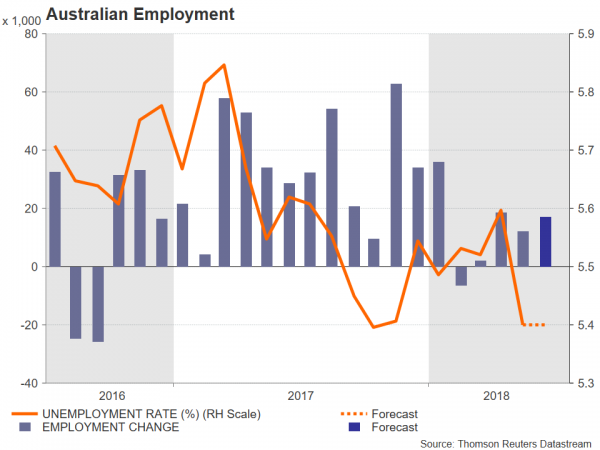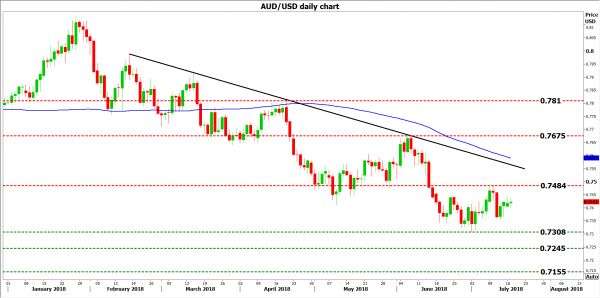Australian employment data for June will hit the markets on Thursday, at 0130 GMT. The forecast is for another solid jobs report, which would confirm the RBA’s view that the labor market continues to tighten and could help the aussie rebound somewhat. Besides economic data, the other major consideration for the battered Australian currency will be how global trade tensions evolve.
Australia’s labor market had been on a tear throughout 2017, posting robust and consistent gains, though the pace of employment growth has moderated so far in 2018. In the minutes of its latest meeting, the Reserve Bank of Australia (RBA) highlighted as much, with policymakers adding they expect continued solid growth in employment to gradually push the unemployment rate down.
Moreover, the Bank was confident that although wage growth may remain low for a while, a tightening labor market would eventually lead to competition among employers for skilled workers, hence causing wages to pick up over time. Higher wage growth is key for the RBA, not only because it’s considered a precursor to higher inflation down the road, but also because Australian households are heavily indebted and a pickup in wages is the easiest way to cure high levels of debt. That said, wage figures will not be reported in this release. Instead, Australia’s wage price index for Q2 will be released on August 15.
Turning to the upcoming data, in June, Australia’s unemployment rate is projected to have held steady at a five-year low of 5.4%. Meanwhile, the net change in employment is forecast to have risen by 17k, above both the 12k increase in May and the average for this year (12.4k).
A stronger-than-expected report, where the net change in employment is higher than projected – hence amplifying speculation wages may pick up faster – could help the aussie recover some of its recent losses. Technically, looking at aussie/dollar, advances may encounter immediate resistance around 0.7484, the high of July 9. An upside break would bring the June 6 peak of 0.7675 into view, before the high of April 19 at 0.7810 attracts attention.
On the downside, and in case of a disappointment in these data, a first line of support to declines may come near the 18-month low of 0.7308 posted on July 2. A downside break could open the way for 0.7245, marked by the inside swing high on 30 December 2016. Even lower, declines could stall around the low of 23 December 2016, at 0.7155.
Finally, besides economic data, the other consideration for the aussie will be how global trade tensions play out. Australia relies on commodity exports and has close economic ties to China, so a potential escalation in the US-China standoff could have severe implications for the Australian economy. Such worries were probably behind the aussie’s notable decline in recent months. The latest signals suggest another round of US-China negotiations may be on the cards. If so, that could cause the aussie to rebound somewhat. Conversely, any further escalation – such as the US moving forward with the $200bn tariffs it announced recently – could keep the Australian currency under pressure.















